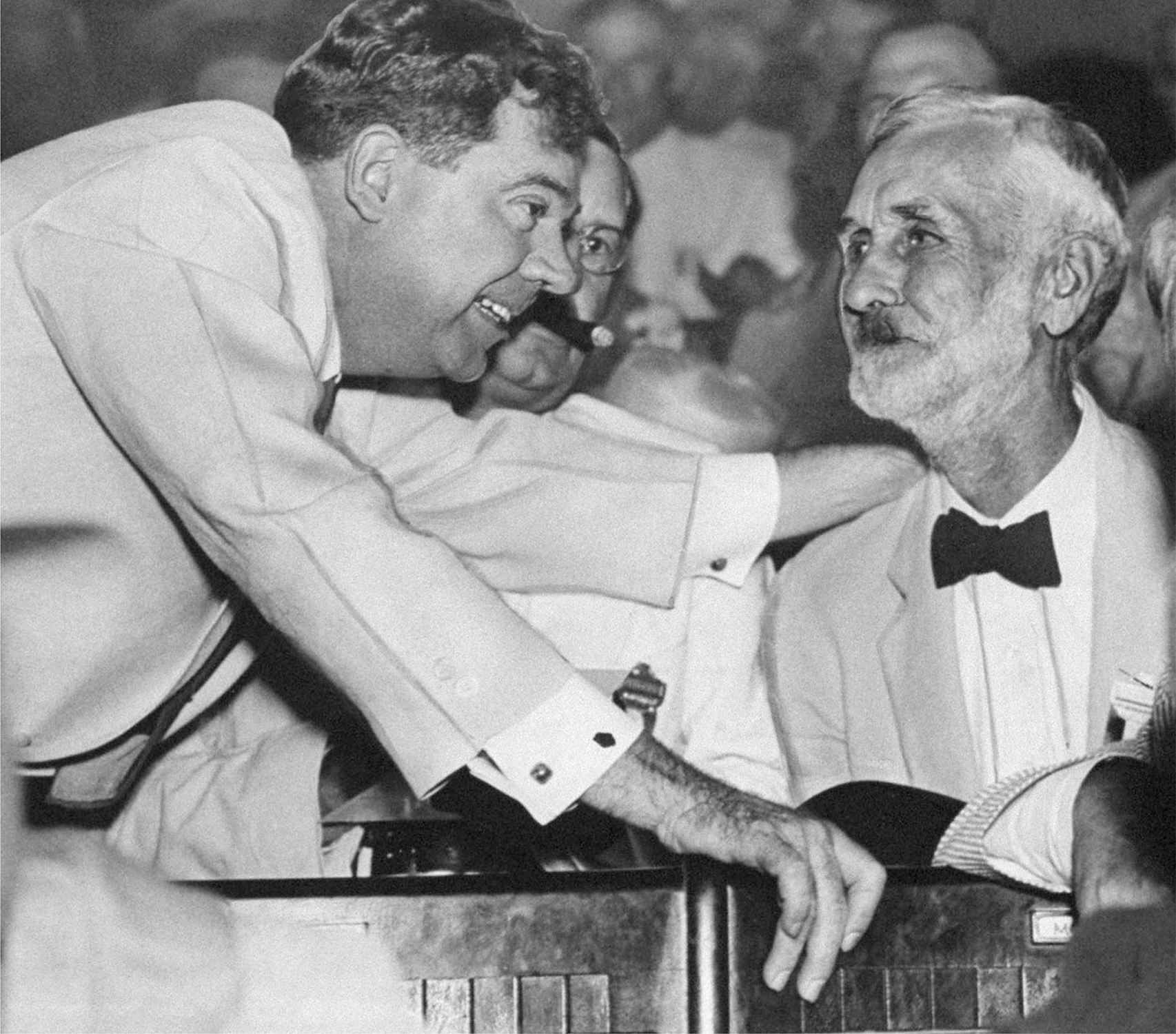The American Promise:
Printed Page 691
The American Promise Value
Edition: Printed Page 646
Chapter Chronology
Politics on the Fringes
Politically, the New Deal’s staunchest opponents were in the Republican Party—organized, well-heeled, mainstream, and determined to challenge Roosevelt at every turn. But the New Deal also faced challenges from the political fringes, fueled by the hardship of the depression and the hope for a cure-all.
Socialists and Communists accused the New Deal of being the handmaiden of business elites and of rescuing capitalism from its self-inflicted crisis. Socialist author Upton Sinclair ran for governor of California in 1934 on a plan that the state take ownership of idle factories and unused land and then give them to cooperatives of working people, a first step toward putting the needs of people above profits. Sinclair lost the election, ending the most serious socialist electoral challenge to the New Deal.
Some intellectuals and artists sought to advance the cause of more radical change by joining left-wing organizations, including the American Communist Party. At its high point in the 1930s, the party had only about thirty thousand members, the large majority of them immigrants, especially Scandinavians in the upper Midwest and eastern European Jews in major cities. Individual Communists worked to organize labor unions, protect the civil rights of black people, and help the destitute, but the party preached the overthrow of “bourgeois democracy” and the destruction of capitalism in favor of Soviet-style communism. Such talk attracted few followers among the nation’s millions of poor and unemployed. They wanted jobs and economic security within American capitalism and democracy, not violent revolution to establish a dictatorship of the Communist Party.
More powerful radical challenges to the New Deal sprouted from homegrown roots. Many Americans felt overlooked by New Deal programs that concentrated on finance, agriculture, and industry but did little to produce jobs or aid the poor. The merciless reality of the depression also continued to erode the security of people who still had jobs but worried constantly that they, too, might be pushed into the legions of the unemployed and penniless.
A Catholic priest in Detroit named Charles Coughlin spoke to and for many worried Americans in his weekly radio broadcasts, which reached a nationwide audience of 40 million. Father Coughlin expressed outrage at the suffering and inequities that he blamed on Communists, bankers, and “predatory capitalists” who, he claimed, appealing to widespread anti-Semitic sentiments, were mostly Jews. Coughlin became frustrated by Roosevelt’s refusal to grant him influence, turned against the New Deal, and in 1935 founded the National Union for Social Justice, or Union Party, to challenge Roosevelt in the 1936 presidential election.
Dr. Francis Townsend, of Long Beach, California, also criticized the timidity of the New Deal. Angry that many of his retired patients lived in misery, Townsend proposed in 1934 the creation of the Old Age Revolving Pension, which would pay every American over age sixty a pension of $200 a month. To receive the pension, senior citizens had to agree to spend the entire amount within thirty days, thereby stimulating the economy.
Townsend organized pension clubs and petitioned the federal government to enact his scheme. When the major political parties ignored his impractical plan, Townsend merged his forces with Coughlin’s Union Party in time for the 1936 election.

Huey Long Huey Long, U.S. senator and former governor of Louisiana, pressured delegates at the 1932 Democratic convention into supporting Franklin Roosevelt, as depicted here. After Roosevelt’s election, Long challenged the president from the left with his Share Our Wealth plan and, until he was assassinated in 1935, campaigned to replace Roosevelt on the Democratic ticket in the next presidential election. NY Daily News via Getty Images.
A more formidable challenge to the New Deal came from the powerful southern wing of the Democratic Party. Huey Long, son of a backcountry Louisiana farmer, was elected governor of the state in 1928 with his slogan “Every man a king, but no one wears a crown.” Unlike nearly all other southern white politicians who harped on white supremacy, Long championed the poor over the rich, country people over city folk, and the humble over elites. As governor, “the Kingfish”—as he liked to call himself—delivered on his promises to provide jobs and build roads, schools, and hospitals, but he also behaved ruthlessly to achieve his goals. Long delighted his supporters, who elected him to the U.S. Senate in 1932, where he introduced a sweeping “soak the rich” tax bill that would outlaw personal incomes of more than $1 million and inheritances of more than $5 million. When the Senate rejected his proposal, Long decided to run for president, mobilizing more than five million Americans behind his “Share Our Wealth” plan. “Is that right,” Long asked, “when . . . more [is] owned by 12 men than . . . by 120,000,000 people? . . . They own the banks, they own the steel mills, they own the railroads, they own the bonds, they own the mortgages, they own the stores, and they have chained the country from one end to the other.” Like Townsend’s scheme, Long’s program promised far more than it could deliver. The Share Our Wealth campaign died when Long was assassinated in 1935, but his constituency and the wide appeal of a more equitable distribution of wealth persisted.
The challenges to the New Deal from both right and left stirred Democrats to solidify their winning coalition. In the midterm congressional elections of 1934—normally a time when a president loses support—voters gave New Dealers a landslide victory. Democrats increased their majority in the House of Representatives and gained a two-thirds majority in the Senate.
REVIEW Why did groups at both ends of the political spectrum criticize the New Deal?
